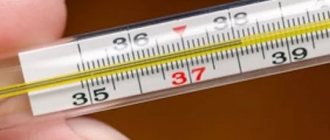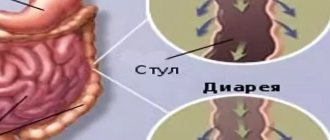What is diarrhea
In medicine, diarrhea (or diarrhea) is a condition of the body accompanied by nausea, frequent loose, watery stools, pain in the abdomen, and sometimes high fever. Diarrhea causes dehydration and is dangerous for the elderly and children, so it is important to know what treatment to use in order to prevent serious consequences.
There are acute and chronic diarrhea. The first lasts up to two weeks and is caused by allergic reactions to medications, food poisoning, and infections. A chronic disease is persistent, prolonged diarrhea with periods of remission. Leads to weakening and dehydration of the body, and may be a symptom of a hidden disease. Causes of long-term constant diarrhea can be ulcerative colitis, Crohn's disease, irritable bowel syndrome.
An intestinal infection is accompanied by severe chills and bloody stool. An urgent visit to a doctor is needed if diarrhea lasts more than five days in adults and two in children, dark bloody stool, severe pain, or dehydration. It is especially important to see a doctor if diarrhea develops after returning from Africa or Asia.
- Cardiac stenting surgery
- Ear congestion without pain - how to treat. Causes of ear congestion without pain
- Egg soup: recipes with photos
Video about intestinal infections
The most common causes of vomiting, diarrhea and fever 37-38 are intestinal infections caused by viruses and bacteria. Viral infections are:
- enterovirus infection;
- rotavirus disease;
- adenovirus infection.
Bacterial intestinal infections include
- salmonellosis;
- dysentery;
- food poisoning.
In this regard, it is the failure to comply with sanitary and hygienic standards at the stage of preparing food, its consumption, and the lack of personal hygiene that leads to the spread of the disease. In some cases, as, for example, with food poisoning, the phenomena of acute gastritis, and therefore vomiting, come to the fore.
All intestinal infections are characterized by the presence of pain localized in the epigastric region or central parts of the abdomen. With dysentery, there is a painful urge to defecate, which is a pathognomonic symptom. The severity of the condition is assessed by the number of cases of stool and symptoms of intoxication.
In adults, symptoms of temperature 39, vomiting, diarrhea are most characteristic of salmonellosis. The nature of stool is important for diagnosing diseases. Rotavirus infection and salmonellosis are characterized by loose, watery stools without pathological impurities. Dysentery - stool mixed with blood. However, the final diagnosis can only be confirmed by laboratory diagnostics, including examination of stool, vomit, and food debris.
What is temperature
Body temperature is understood as an indicator of the thermal state of the human body, reflecting the relationship between organs and the external environment. Increased and high body temperature is dangerous for humans: up to 38 is subfebrile, up to 39 is febrile, up to 41 is pyretic, above 41 is hyperpyretic. The critical indicator is 42 degrees - at this temperature, brain tissue is destroyed, which leads to death.
The causes of fever are viruses and bacteria. The fever is accompanied by fatigue, weakness, dry skin, mucous membranes, mild or severe chills. A reading above 38.5 degrees is a reason to urgently call a doctor at home, especially if a person has muscle aches, pain in the limbs, arrhythmia, or loss of appetite.
https://youtu.be/rS7Gn9ENGHY
Folk remedies
To eliminate symptoms:
- Chamomile decoction eliminates spasms and pain in the intestines or stomach.
- Tea with lemon and mint leaves when there is severe nausea and loss of strength.
- A decoction of dill in small portions to restore peristalsis, relieve pain or abdominal cramps.
- A small portion of ginger tea eliminates vomiting, diarrhea and fever. Excessive consumption will have the opposite effect.
- Pomegranate tincture is a natural sorbent used to remove toxins, relieve gastrointestinal disorders and eliminate infections. Pour 2 tablespoons of ground crusts into 0.5 liters of boiling water, leave for 30 minutes and drink in small portions all day.
Traditional medicine methods are also far from powerless in relieving symptoms such as body aches, chills, vomiting, diarrhea and fever. Decoctions and infusions restore the patient’s strength and speed up recovery:
- Spasmodic pain in the stomach and intestines can be relieved with a weak decoction of chamomile.
- If nausea sets in and the patient feels exhausted, tea with lemon and mint leaves will help.
- When your bones ache, rose hips will help. Thanks to their diuretic effect, they help reduce fever, and tea with cranberry and linden blossom tones and relieves chills.
- A decoction of dill seeds is taken to get rid of cramps and abdominal pain. Taking it in small portions not only relieves pain, but also restores peristalsis.
- Ginger tea in small quantities relieves vomiting, diarrhea and helps reduce fever in an adult. To achieve the effect, you do not need to consume it in large quantities, as it is very aromatic and can cause the opposite effect. One spoon several times a day is enough.
- An infusion of pomegranate peels is a natural sorbent that successfully fights toxins in gastrointestinal disorders and helps quickly rid the body of infection. To prepare it, you will need two tablespoons of ground crusts, into which you need to pour 400 ml of boiling water. You need to keep the broth covered for thirty minutes, after which it can be consumed throughout the day in small portions.
Vomiting and diarrhea can be effectively treated with traditional medicine. Some recipes will relieve such unpleasant symptoms as nausea, chills, weakness, improve the general condition of the patient, and give him strength. For example:
- Chamomile decoction helps with spastic intestinal pain.
- Chills and high fever can be treated with linden and cranberry tea, as well as rose hip decoction. The sweating that occurs when taking them relieves heat naturally.
- Fennel seeds are also good for stomach pain; they gently relieve cramps, bloating, and normalize digestion. You need to drink the decoction several times a day in small portions.
- Vomiting, diarrhea, and fever can be easily relieved with ginger tea, but it must be taken one tablespoon at a time. It has been verified that with this intake a person stops vomiting, and nausea is noticeably weakened.
Treatment with folk remedies is recommended to be used as auxiliary therapy. Very often, these methods help to significantly alleviate the patient’s condition, as well as to recover from an illness.
Fever and diarrhea in an adult
If a person has a high fever and diarrhea at the same time, doctors suggest a diagnosis of acute diarrhea. It can be caused by viral, parasitic or bacterial infections. The causes of acute diarrhea are a viral disease, traveler's diarrhea. The causative agents of the combination of diarrhea and fever are:
- E. coli – infects meat, fish, milk, vegetables, fruits, water. The infection is transmitted from person to person, symptoms are watery stools with blood, vomiting.
- Salmonella - contains raw milk and poorly fried eggs. An excited illness is accompanied by acute abdominal pain, fever, and a frequency of diarrhea 12-15 times a day;
- Shigella - found in food products, loose stools with blood, abdominal cramps are observed;
- Rotavirus (viral infection) - you can become infected from others, a person is bothered by vomiting, nausea, and diarrhea.
Surgical pathology
The most common surgical pathology that occurs with vomiting and fever in adults is acute appendicitis. It is characterized by a shift of pain from the epigastric region to the right iliac region. The nature of the pain is constant, intensifying when turning on the left side. There are no pathognomonic symptoms of the disease, which makes diagnosis difficult.
To clarify the diagnosis, the level of blood leukocytes is monitored already in the surgical department. An increase in leukocytosis indicates acute appendicitis. Appendectomy is the only treatment for this disease. If surgical intervention is not performed in a timely manner, peritonitis may develop, which will significantly complicate the course of the operation and the postoperative course.
Causes
Loose stools and fever in adults or children are more often associated with food poisoning. Other reasons are:
- eating a lot of food;
- allergic reactions;
- exceeding the dosage of medications;
- severe stress, emotional tension;
- sudden climate change;
- damage to the gastrointestinal tract by an infectious disease;
- stomach ulcer, gastritis;
- poisoning with heavy metals, poisons, chemical toxins;
- radiation damage.
Diarrhea, nausea, fever
Diarrhea with fever and nausea serves as a protective reaction to toxins entering the body. The reasons for the development of these symptoms together are:
- abuse of fatty foods with enzyme deficiency;
- cholera, hepatitis;
- gastritis, ulcer, inflammation of the pancreas, cholecystitis;
- poisoning with mercury vapor, nitrates, poisonous mushrooms.
Loose stools and temperature 37
When diarrhea and a temperature of 37 degrees appear, doctors may suspect gastroenteritis or intestinal flu due to viruses entering the intestines. Their toxins cause inflammation that affects the intestinal mucosa. A person becomes contagious to other people. Viruses can enter the body through food and drinks:
- with unwashed fruits, expired food;
- with unboiled water, when swimming in an infected body of water;
- airborne through sneezing or interacting with large numbers of people.
The incubation period lasts 16 hours, after which the intestinal mucosa is destroyed. Signs of a dangerous disease are:
- frequent liquid diarrhea – 10 times a day;
- nausea, vomiting, cough, sore throat;
- mucus in stool;
- gray-yellow clay-like stool color;
- pain in the stomach area.
- Lettering for tattoos with translation
- Recipes for cooking barley porridge in a slow cooker
- System minus 60 by Ekaterina Mirimanova for weight loss
Diarrhea and temperature 38 in an adult
With severe diarrhea and a temperature of 38 degrees, doctors diagnose “damage to the gastrointestinal tract due to the development of infection.” The causes may be an overdose of antibiotics, hormonal non-steroidal drugs, and digestive disorders. The latter can be caused by overeating or eating low-quality foods. If you feel worse, visit a gastroenterologist or therapist.
Fever, nausea, diarrhea, weakness
Symptoms of food poisoning include weakness, high fever and watery diarrhea in an adult or child. They appear suddenly after eating foods, without an incubation period. Two hours after ingestion, the pathogen (infection of microbes, viruses or ingestion of chemical toxins) acts on the body. Characteristic symptoms are:
- liquid stool that comes out spasmodically;
- decreased blood pressure;
- cold sweat;
- When poisoned by poisons, vision and brain function are impaired, and muscles lose tone.
Non-communicable diseases
In addition to intestinal infections, characterized by the nutritional route of infection and the development of symptoms of damage to the gastrointestinal tract, there is a large group of diseases of a non-infectious nature, also characterized by the development of vomiting, diarrhea and fever 37-38. These include
- Crohn's disease,
- nonspecific ulcerative colitis;
- autoimmune diseases affecting the digestive system;
- enteritis;
- colitis;
- pancreatitis;
- ulcer of the stomach and duodenum.
Peptic ulcer of the stomach and duodenum is characterized by hunger pain, nighttime, and often vomiting of acidic contents. When complicated by bleeding, the vomit takes on the appearance of coffee grounds, and the stool becomes tarry due to the admixture of blood in it. Exacerbations of these chronic diseases are also accompanied by an increase in temperature.
Diagnosis of the disease involves performing fibrogastroduodenoscopy, which makes it possible to detect areas of ulceration. In recent years, the leading role in the development of this disease has been assigned to the bacterium Helicobacter Pylori, and therefore the prescription of treatment, in addition to drugs that improve motility, antispasmodics, healing drugs that reduce acidity, also includes antibiotic therapy.
Diarrhea and fever in childhood
In babies, the dangerous temperature for diarrhea is 37 degrees or more. The causes of these symptoms are:
- eating disorder, intoxication of the body - pale face, cold feet and hands, stomach pain;
- reaction to medications;
- acetonemic syndrome - lack of carbohydrates, past infectious diseases of the digestive system, stress, manifested by vomiting, unpleasant odor of acetone from the mouth;
- teething - gums may begin to swell;
- failure to comply with hygiene rules – signs of poisoning are visible;
- helminthic infestations - severe diarrhea;
- gastritis, colitis, dysbacteriosis - signs of toxins entering the body disappear with medication;
- enterovirus – bloody diarrhea (invasive bloody diarrhea);
- rubella, scarlet fever, measles - rashes on the skin;
- flu, sore throat, otitis media, pharyngitis – redness of the throat, enlarged tonsils, nasal congestion, temperature may rise;
- dysentery, salmonellosis - green feces with mucus.
Possible complications
Fever and diarrhea in an adult can cause various complications, namely:
- Anemia of the intestines and irritation of the mucous membrane, resulting in impaired metabolism and food poisoning (weight loss or anorexia may occur).
- The development of infectious diseases of the gastrointestinal tract, which disrupt the process of food etching and provoke constant diarrhea, flatulence and other symptoms.
- The development of gastritis, ulcers, polyps and other diseases that occur for various reasons, including infectious diseases and frequent diarrhea.
- Enlargement and inflammation of the liver, spleen, bile and other internal secretion organs, which threatens mononucleosis and intoxication of the body.
Frequent diarrhea is caused by inability to digest food, which can lead to anorexia and weight loss. This is due to intestinal anemia, as a result of which diarrhea and indigestion become chronic and occur regularly after meals.
What to do
Home treatment can reduce the impact of dangerous symptoms, provided that the following recommendations are followed:
- give the patient plenty of drink - Borzhom or Essentuki mineral water, dried fruit compotes, weak fruit drinks, weak tea with honey;
- follow a dietary diet – boiled cereals, vegetable soups;
- take fermented milk products, non-acidic cheeses, low-fat cottage cheese;
- drink starchy jelly for health;
- eat more boiled vegetables and baked fruits;
- You can bring down the temperature above 38 degrees with Nurofen, Aspirin, Paracetamol;
- take calcium supplements, pro- or prebiotics with pectin, acidophilus.
First aid
If the temperature rises and bowel movements appear, the first aid for the patient will be the following measures:
- at the first signs of intestinal poisoning, induce vomiting to lavage the stomach - drink a solution of potassium permanganate or soda, repeat until the stomach is completely empty, then take an absorbent;
- to prevent signs of dehydration, every 10 minutes give the patient a sip of Regidron (a packet per liter of water), drink plenty of fluids;
- on the first day of treatment for severe weakness, you should refuse to eat, drink more and rest, then follow a light diet and drink broths;
- The temperature during diarrhea should not drop to 37 degrees (it indicates that the body is in the process of independently fighting the infection). In this situation, provide the patient with complete rest.
Drug treatment
In case of a complicated course of the disease, diagnostics are required to prescribe the correct drugs for treatment. Diagnosis measures include the use of coprograms, stool tests for dysbacteriosis and helminths, general and biochemical blood tests, and abdominal ultrasound. Depending on the cause of diarrhea, treatment methods include:
- reception of sorbents.
- gastric lavage in case of severe vomiting;
- rehydration therapy for fluid loss - Regidron, Gastrolita, Citroglucosolan, chamomile tea, pharmaceutical saline solution;
- antipyretics for headaches - Paracetamol, Nurofen;
- taking fluoroquinolone antibiotics or cephalosporins - in severe condition, presence of blood in diarrhea
- lacto- and bifidobacteria to restore intestinal microflora during rotavirus infection;
- taking anti-inflammatory drugs on the first day of illness - Indomethacin, Diclofenac, Sulfasalosin;
- When diarrhea occurs, it is useful to take Festal or Mezim to stimulate intestinal function and remove toxins.
Traditional treatment
If diarrhea and high fever appear in an adult or child, you can use traditional medicine recipes to help get rid of dehydration:
- Taking rice or pomegranate broth, mint infusion, fresh blueberries.
- Consuming dry starch dissolved in water, diluted carrot puree, chamomile or mint tea.
- Taking rehydration solutions - take a tablespoon of sugar, a teaspoon of salt and half a teaspoon of soda per liter of boiled water. Or dissolve eight teaspoons of sugar, a teaspoon of salt, and the fresh juice of two oranges or grapefruits in a liter. It is necessary to give the patient food every five minutes in small portions.
Treatment
It can be performed at home or in a hospital - it depends on the type of pathology and the patient’s condition. Some diseases that involve a risk of infecting others require isolation. With frequent vomiting and diarrhea, dehydration develops, which cannot be replenished only with oral rehydration (taking fluids through the mouth) - intravenous infusion of drugs is necessary. Thus, the treatment algorithm is determined by many factors; however, there are standard measures that are indicated for all patients with diarrhea and fever.
Rehydration
Restoring water and electrolyte balance is one of the key goals of therapy for diarrhea, especially in patients with elevated body temperature. An adult with mild dehydration can drink liquids on his own:
- Water.
- Saline solution (Regidron, Gastrolit, Ionica).
The general target volume of oral fluid intake for an adult is 2 to 3 liters per day.
Intravenous infusion is started if weight loss in 24 hours is 10% or more. If a patient cannot eat due to vomiting or immediately empties the stomach of food taken, not only saline solutions are needed, but also glucose.
Diet
It should be gentle: the intestines affected by the inflammatory process, like other organs of the gastrointestinal tract, should not be subjected to standard, much less excessive, load. To speed up recovery, you should include foods such as:
- Slimy soups.
- Boiled rice.
- Dried bread.
- Baked potatoes.
- Lean meat, pureed.
- Steamed egg omelet.
Excludes:
foods rich in fiber (whole grain bread, fresh fruits and vegetables);
- dairy products;
- coffee, chocolate, spices;
- baked goods, spicy seasonings, alcohol;
- eggs, fish, fatty meat;
- sausage.
It is recommended to eat little by little, according to your appetite. The diet is followed for 2-3 days, later a decision is made to expand the diet - it depends on the patient’s condition.
Contrary to numerous misconceptions, if you have diarrhea, it is not at all necessary to fast. Of course, there are diseases for which temporary refusal of food is justified: pancreatitis or other pathologies that require minimal stress on the digestive system or require emergency surgical intervention. However, with intestinal infections during a period of high fever, the patient usually tolerates hunger without difficulty, but after normalization of body temperature and the beginning of replenishment of fluid deficiency, he begins to have an appetite, which can be considered as a favorable sign.
Drug therapy
It is selected depending on the variant of the disease. In case of acute intestinal infections, food poisoning, it can be symptomatic (saline solutions for rehydration, sorbents (Smecta, Enterosgel)) or etiotropic - that is, aimed at eliminating the causative factor of the pathology. In the second case, antimicrobial drugs are used (Ampicillin, Chloramphenicol, Nifuroxazide).
For the treatment of pseudomembranous colitis, first of all, the abolition of drugs that caused its development is used. However, if Clostridium difficile infection is proven, two antimicrobial options are used: Vancomycin and Metronidazole. Rehydration and the intake of probiotics are also required - preparations containing live bacteria designed to restore the balance of intestinal flora.
In case of chronic pancreatitis against the background of hunger (1-3 days), the patient is injected with myotropic antispasmodics (Mebeverine), painkillers (Ketoprofen, Tramadol), proton pump inhibitors (Pantoprazole), histamine H2 receptor blockers (Famotidine).
In the treatment of chronic cholecystitis, antibacterial drugs (Cefotaxime, Clarithromycin), antispasmodics (Drotaverine), and antiemetics (Metoclopramide) are used. If there are stones in the gall bladder, surgical intervention is necessary.
Prevention
To prevent weakness, fever, diarrhea and vomiting, you need to follow simple but effective rules of prevention:
- When preparing food, observe the shelf life of products;
- Avoid self-treatment with antibiotics;
- store ingredients only in the refrigerator in compliance with the commodity proximity, do not keep raw meat next to fresh vegetables;
- choose only high-quality food products, without expired expiration dates;
- do not eat raw fish in rolls, cook steaks without blood, do not drink unpasteurized milk, untested water;
- wash your hands more often;
- eliminate insects in the kitchen;
- wash dishes thoroughly.











